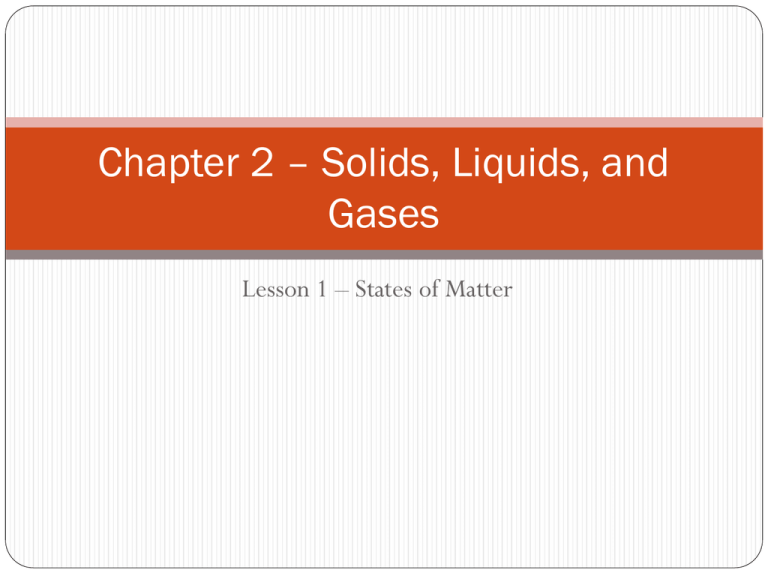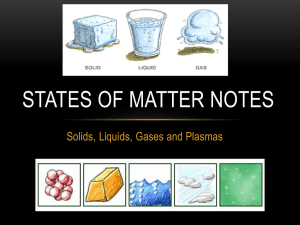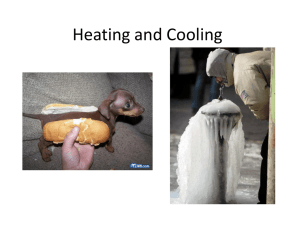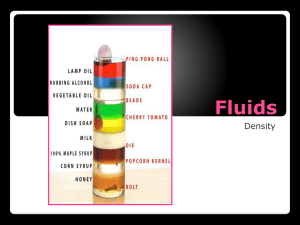Chapter 2 – Solids, Liquids, and Gases
advertisement

Chapter 2 – Solids, Liquids, and Gases Lesson 1 – States of Matter Solids Your everyday world is full of substances that can be classified as solids, liquids, or gases. Solids, liquids, and gases may be elements, compounds, or mixtures. The familiar states of matter are defined not by what they are made of, but mainly by whether or not they hold their volume and shape. A solid has a definite shape and volume Particles in a Solid The fixed, closely packed arranged particles cause solids to have a definite shape and volume. The particles vibrate, meaning they move back and forth slightly. This motion is similar to a group of people running in place. Types of Solids In many solids, the particles form a regular, repeating pattern which create crystals. Plastic, rubber, and glass are amorphous solids. Unlike, crystalline solids, amorphous solids do not melt at a distinct temperature. Instead, it may become softer or change into a different substance. Liquids Like a solid a liquid does have a constant volume, but no definite shape. A liquid takes the shape of its container, but its volume doesn’t change. Particles and Properties of a Liquid Particles in a liquid are packed close together, but move freely which allows the liquid to flow from place to place. One characteristic of liquids is surface tension. Due to surface tension, the surface of water can act like a sort of skin. Another characteristic of liquids is viscosity. A liquids viscosity depends on the size and shape of its particles and the attractions between the particles. Some liquids flow more easily than others. Liquids with low viscosity flow quickly and high viscosity flows slowly. Gases Like a liquid, gas is a fluid. If you put gas in a closed container, the gas particles will either spread apart or be squeezed together as they fill that container. As they move, gas particles spread apart, filling in all the space available. Thus, a gas has neither definite shape nor definite volume. Lesson 2 – Changes of State Changes Between a Solid and a Liquid Particles of a liquid have more thermal energy than particles of the same substance in solid form. As a gas the particles of this same substance have even more thermal energy. A change from a solid to a liquid involves an increase in thermal energy, and a change from a liquid to a solid involves a decrease in thermal energy. Melting and Freezing In most pure substances, melting occurs at a specific temperature. At its melting point, the particles of a solid substance are vibrating so fast that they break free from their fixed position. At its freezing temperature, the particles of a liquid are moving so slowly that they begin to form regular patterns. Changes Between a Liquid and a Gas Vaporization takes place when the particles in a liquid gain enough energy to form a gas. There are two main types of vaporization – evaporation and boiling point. Evaporation and Boiling Vaporization that takes place only on the surface of a liquid. Ex: Shrinking puddle Occurs when a liquid changes to a gas below its surface as well as at the surface. As with melting points, chemists use boiling points to help identify an unknown substance. Boiling Point and Air Pressure The boiling point of a substance depends on the pressure of the air above it. The lower the pressure, the less energy needed for the particles of the liquid to escape into the air. Condensation Condensation occurs when particles in a gas lose enough thermal energy to form a liquid. You cannot see water vapor. It is a colorless gas. Changes Between Solid and Gas During sublimation, particles of a solid do not pass through the liquid state as they form a gas. Ex: Dry ice Lesson 3 – Gas Behavior Measuring Gas When working with a gas, it is helpful to know its volume, temperature, and pressure. Gases easily contract or expand Volume Volume is the amount of space matter fills and is measured in cubic centimeters, milliliters, liters, and other units. Because gas particles move and fill the space available, the volume of a gas is the same as the volume of it container. Temperature Temperature is a measure of the average energy of random motion of the particles of a substance. The faster the particles are moving, the greater their energy and the higher the temperature Pressure Gas particles constantly collide with one another and with the walls of their container. As a result, the gas pushes on the walls of the container. The firmness of a gas-filled object comes from the pressure of the gas. Boyle’s Law Boyle found that when the pressure of a gas at constant temperature is increased, the volume of the gas decreases. When the pressure is decreased, the volume increases. Boyle’s Law applies to situation in which the volume of a gas is changed. Then the pressure changes in the opposite way. Pressure and Temperature Gas particles travel individually and at high speeds (but randomly). The faster the gas particles move, the more frequently they collide with the walls of their container and the greater the force of the collisions. Ex: falling sand grains vs. sandstorm When the temperature of a gas at constant volume is increased, the pressure of the gas increases. When the temperature is decreased, the pressure of the gas decreases. Charles’s Law Charles found that when the temperature of a gas is increased at constant pressure, its volume increases. When the temperature of a gas is decreased at constant pressure, it’s volume decreases. Boyle, Charles, and others often described the behavior of gases by focusing on only two factors that vary at a time.







